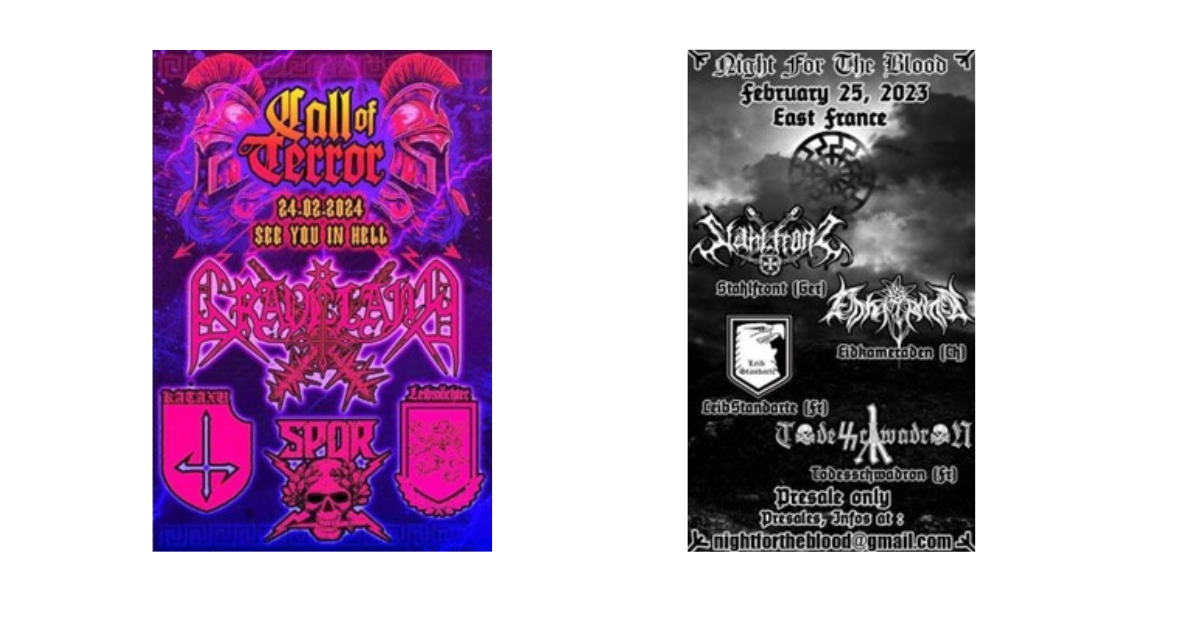In the span of just a few days, two events raising concerns over the spread of hate speech unfolded in France, attracting varying levels of media and political attention. On 21 February 2024, French Minister of the Interior Gerald Darmanin requested the emergency expulsion of the Imam Mahjoub Mahjoubi, accused of using his preaches to spread heinous and dangerous speech. Three days later a neo-Nazi festival, organised despite its ban in the region of Lyon, went relatively unnoticed.
This double standard may be indicative of an unbalanced consideration of the threat posed by Islamist and far right extremism, together with a misunderstanding of the risks posed by white power music festivals and concerts. Yet, right wing extremist (RWE) concerts are not new, and are one aspect of an ideologically motivated musical radical sphere. White power music represents “an umbrella category that encompasses many local music scenes and various types of pro–white racist music” such as, for instance,Rock Against-Communism (RAC), and National Socialism Black Metal (NSBM), that share a hateful xenophobic and antisemitic narrative. NSBM and white power music concerts can have consequences for the development of RWE groups, and the radicalisation and socialisation of their members. However, the threat they pose remains overlooked and benefits from lighter media and political attention.
This analysis aims to shed light on the dynamics behind the white power music scene in France and its regional connections, and to reflect on the risks posed by these events. Following a brief overview of the dynamics behind their organisation, this analysis will explore the fundraising, networking, and recruiting opportunities that music festivals and concerts represent for RWE movements, as well as the challenges and gaps in current responses.
The Backstage of Neo-Nazi Festivals Organisation in France
Over the last year, France has been host to several concerts and events of NSBM and RAC music. These events are not novel, yet their resurgence is more salient following their decreasing occurrence during the pandemic. Since 2023, at least five known events were identified and subsequently banned by law enforcement. However, only the Night for the Blood in Remoneix and the Franc Tireurs Patriotes concert in Lille, respectively planned in February and June 2023, were cancelled by their organisers. The RAC festival Rock Anti-Wokism in Saint-Quentin-Fallavier (Isère), La Crémaillere in Respordon (Finistère) and the fifth edition of the Call of Terror festival in Vézeronce-Curtin (Isère) were maintained despite prefectural decrees. Moreover, some of these events go unnoticed until the last minute, as in Saint-Cyr-l’École, where a right-wing demonstration in Paris transformed into a NSBM concert in the evening.
French organisers display a simple, but efficient modus operandi to bypass authorities’ control. Events are generally advertised online within far right networks and communication channels, with organisers trying to go unnoticed by using private messaging apps and more fringe or encrypted platforms, such as Telegram to promote their events. NSBM events in France display a relatively high level of secrecy as compared to the mainstream communication used for some larger events, such as the Ukrainian Asgardsrei festival, created by Alexander Levkin, a member of the Azov Regiment, that was held annually in Kyiv before the pandemic. The cultural and legal divergences explain the different scales of these events and the more restrained accessibility of these events in Western Europe. Yet, promotion for the Call of Terror 2024 was noticeably also disseminated on mainstream social media, including through an Instagram account.
In the meantime, venues (typically municipal facilities) are booked under false pretences, such as a birthday party, to avoid alerting local authorities to the true motive of the reservation. A few hours before the event, organisers share the location of the venue to the participants who have bought a ticket online via private messages. Capacities of the venues can vary, while the Call of Terror welcomed around 150, the Rock Anti-Woke gathered around 200 to 300 individuals, and the Saint Cyr l’École neo-Nazi concert around 300 participants.

Poster for the Call of Terror 2024 and Night for the Blood 2023
The paraphernalia and imagery referring to Nazi-Germany and fascism is central to the aesthetic of the NSBM scene. While some defend the use of this aesthetic as a means to shock, the symbols and historical references inserted in bands names, concerts’ posters, and even the event dates, along with the secrecy shrouding their organisation realistically leaves little doubt as to the ideology they promote. For instance, 24 February was chosen for the Call of Terror festival in reference to the date of the creation of the National Socialist German Workers' Party (Nationalsozialistische Deutsche Arbeiterpartei, or NSDAP). The top and bottom lines of the poster are a reference to the Meandros flag, symbol of the Greek neo-Nazi party Golden Dawn, and under the date of the event, thunders can be seen taking the shape of SS bolts, symbol of the Waffen Schutzstaffel, or Nazi Germany SS infantry division. Similarly, the Night for the Blood poster contains multiple ancient symbols appropriated by Nazis, including a Sonnenrad (sunwheel), or black sun, and in each corner, Life and Death Runes, symbols used on SS graves to mark dates of birth and death. Moreover, the bands’ names and logos are also unequivocal, with for instance the group Leibwächter (bodyguards) being in reference to Adolf Hitler’s bodyguards. The logo of the band Kataxu displays a Gibor Rune, symbol of the SS division Das Reich, inserted in a reversed cross, while the logo of the band Todesschwadron notably displays Totenkopf (death’s head), which was notably the emblem of the SS division in charge of guarding Nazi Germany concentration camps. Lastly, the logo of the most important band of the concert, the polish group Graveland, exhibits a reversed cross inside a Celtic cross, a symbol of white supremacy.
Loud Consequences: Fundraising, Networking, and Radicalising Grounds
Concerts and music festivals gathering a few hundred individuals might appear as relatively minor incidents, particularly in light of the series of large-scale jihadist attacks conducted in France over recent years. They however play vital functions for RWE movements in the country and across Europe.
Far right music festivals notably serve as a source of income for RWE movements. Alongside ticket sales, additional funds are raised through catering, merchandise, and memorabilia sales at the events and online. In 2018 alone, far right music festivals held in Germany yielded an estimated revenue ranging between 1.5 and 2 million euros. While Germany, along with a few other countries such as Ukraine and Poland, are known for hosting particularly large festivals gathering thousands of spectators, the European underground neo-Nazi music scene is also composed of smaller “mini-festivals” and concerts, such as the Call of Terror and other aforementioned festivals that have taken place in France. Still, research estimates that small- (from 120 to 150 visitors) to medium- (from 200 to 250 visitors) size concerts might raise benefits ranging from €1,150 to €2,900. Proceeds are largely reinvested to finance RWE networks’ activities and events, with investigations showing that they notably cover the legal costs of fellow neo-Nazis facing trials.

Example of merchandise sold at the Call of Terror 2024 festival, advertised by the band SPQR on its Facebook page prior to the event.
The significance of music festivals for far right movements extends far beyond financial gains, however. Acting as central networking hubs, they are opportunities to strengthen ties among transnational extreme right-wing networks, with research showing that individuals from the RWE milieu in Europe often travel to attend concerts in multiple foreign countries. Experts notably point out France “for having one of the strongest and best-networked NSBM scenes in Europe.” Concerts organised in the country include bands from across Europe, with Polish and Italian bands performing at the latest edition of the Call of Terror festival. Similarly, French bands are invited to perform in festivals organised abroad, with for instance the lineup of the Italian Hot Shower festival, named in reference to gas chambers, featuring the French far right band Seigneur Voland. In some cases, RWE movements from across Europe have even co-organised concerts such as the Hammerskins France (French branch of the American Skinhead group) and Blood and Honour (RWE group from the UK).
Besides reinforcing ties and boosting morale among those already committed, RWE concerts provide opportunities to attract and “recruit people who were part of the far right subculture, but unaffiliated to any specific organisation.” For instance, research with former members of the German extreme right found that, for 83 percent of the interviewees, “initial connections to far right networks were primarily built around the music.” Music is a powerful vehicle for violent far right ideology as it “condenses and simplifies ideological tenets into catchy refrains that can be digested by youth.” Incidentally, the use of music as a powerful tool for indoctrination is a longstanding practice, employed by diverse groups extending beyond far right movements, with for instance, the Islamic State having relied on jihadi songs, known as nasheeds. There have been notable examples illustrating how groups have utilised music to expand their influence, with for instance, the Hammerskin Nation having “grown out of the skinhead punk music in the 1980s” to later become one of “the largest, most organised, and most violent neo-Nazi skinhead gang in the U.S.”, with multiple branches across Europe.
Glorifying violence and propagating racist hateful narratives, lyrics can act as ideological manifestos. This is, for example, evident in the discography of the French band Seigneur Voland which includes songs titled “When swastikas starred the sky” (Quand les swastikas étoilaient le ciel), “Last White Bastion” (Dernier Bastion Blanc), “Conquering Eagle” (Aigle Conquérant) or “Youth Purification” (Jeunesse Épuration). Their antisemitic and xenophobic lyrics use derogatory terms like “demons” (démons), or “the Jews and other germs of decay” (les Juifs et autres germes de pourriture) to vilify and dehumanise ethno-religious minorities. They celebrate white supremacy and violence, with statements such as: “It is in glory that I die for my race and my blood” (C'est dans la gloire que je meurs pour ma race et mon sang), “Mother Dachau has produced vengeful, demented children” (Mère Dachau a généré des enfants vengeurs et démentiels), “the yellow star has not burned enough” (l’étoile jaune n'a pas assez brûlée), or among others, “Did I dream of the twelve tribes exterminated by the last white bastion of the German Third Reich” (Ai-je rêvé des douze tribus exterminées par le dernier bastion blanc du IIIème Reich Allemand). By dehumanising and framing specific ethno-religious minorities as a designated enemy, such statements contribute to normalising antisemitic and xenophobic ideas, to desensitising listeners to hateful discrimination and violence, and to justifying, if not encouraging, violence against minorities.
Besides introducing listeners to hateful extremist narratives, research underlines that “the thrill that comes from listening to forbidden music with a close group of friends is likely to facilitate the formation of bonds.” This thrill might be further amplified when transitioning from merely consuming music to attending clandestine live performances, with the secrecy surrounding such events potentially being even more enticing. For instance, festivals like the Call of Terror festivals are indeed often preceded by a kind of “scavenger hunt” with details about the location of the venue being gradually and solely disclosed to ticket holders. The excitement of being part of a subculture community contesting the mainstream norms might indeed contribute to attracting individuals, particularly youth in quest of significance and belonging, by providing them with a new sense of identity and affiliation.
Adolescents and young adults are at a particular stage in their development that makes them more vulnerable to radicalisation. As they define their own identity and values, experiment with different beliefs systems, and crave for a sense of belonging, youth are more susceptible to external influences and ideological appeals, including extreme ones. For socially deprived youth feeling marginalised and disadvantaged, joining a far right group may thus represent a way “of getting recognition for their sense of victimhood.” Furthermore, by allowing face-to-face interactions, concerts bear an important socialisation aspect. Research underscores “an active process of becoming” taking place in far right music festivals, whereby newcomers gain through “informal festival pedagogy” the tools and knowledge about how to be a young far right supporter. Through immersive real-world experience, attendees become acquainted with the language, dress codes, and sanctioned behaviour of “authentic” neo-Nazis. In that sense, and although not every attendee will necessarily become an active member of violent far right organisations, participation in far right music festivals represents a collective experience that may facilitate the identification with the group.
Perhaps even more relevant are the enduring consequences that transcend the immediate moment of physical interaction. After the event concludes, the exhilaration derived from participating in (illicit) underground gatherings, along with the formation of connections to extremist ideology are further bolstered by the post-event digital documentation of the events. Subsequent sharing of accounts, images, and videos of the concerts on social media platforms can serve as “a compelling digital recruitment tool,” prolonging the experience of participants and potentially attracting peers. While cell phones and cameras are often prohibited inside the venue to avoid any leaks, as was reportedly the case for the Call of Terror festival, some events have far less restrictions, resulting in several videos, pictures and accounts of the events being posted on social media platforms. Stage hatred can thereby translate in the further dissemination of extremist content online. Yet, it is also important to emphasise the risks of offline violence, with some instances of far right music figures having turned into violent perpetrators, such as Wade Michael Page, who played in several white power music bands and later massacred six worshippers in a Sikh temple.
Echoes of Silence: Challenges and Gaps in Current Responses
Despite the significant risks associated with neo-Nazi music festivals and concerts, there remains significant gaps in authorities’ responses. A key challenge in effectively addressing these risks lies in the difficulty of detecting their occurrences. Strategies employed by organisers – i.e. booking venues under false pretences, usually in rural villages, advertising these events through private chats, and gradually disclosing event details within restricted groups – significantly complicate efforts to implement preventive measures. Civil society actors, including anti-fascist groups and local independent media, often act as prominent whistleblowers in this regard, alerting authorities of forthcoming events being organised and exerting public pressure on authorities to prohibit these concerts.
When informed about the organisation of an event, authorities’ response usually takes the form of banning orders. Even before the location of the Call of Terror festival could be identified, several prefectural banning orders were adopted on the grounds that the event “constitutes, by its very object, a major threat to public order due to the affront to human dignity caused by the ideology it promotes.” Yet, enforcing these measures often proves challenging. In the case of the Call of Terror festival, organisers were notified about the decree by the gendarmerie but refused to respect the prefectural decision and to cancel the event. As a result, law enforcement units set up checkpoints on the main access roads to the event location and proceeded to carry out 330 vehicle checks with the view of collecting the identities of participants for future legal proceedings. Yet, the concert was maintained and eventually took place.
After the event, an investigation for “participation in a forbidden demonstration” was opened, exposing the organisers to six-month imprisonment and a €7,500 fine, and participants to a fine of a few hundred euros. The Representative Council of Jewish Institutions in France (Conseil représentatif des institutions juives de France, CRIF) of Grenoble Dauphiné moreover requested the enlargement of the investigation to “incitement to hatred” and “apology of a war crime, and crime against humanity,” which would increase the potential sanctions that organisers and participants would be exposed to.
Finally, far right activists strategically exploit differences among European countries’ laws. For instance, eastern France has been host to several far right concerts and gatherings, with German neo-Nazis crossing the border to escape the surveillance of the German police for those subject to criminal prosecution and the country’s stricter legislation restrictions against the promotion of Nazism and Nazi emblems. Similarly, several French bands, such as B*ise ma Hache (“F*ck my Axe”) or Peste Noire (“Black Plague”), and members of the French far right travelled to Kyiv for the annual Asgardsrei festival, allowing them to build connections with Azov regiment members and other European neo-Nazi networks with much fewer restrictions than in many other countries.
Public acknowledgment is lacking when it comes to RWE events. On 22 February 2024, less than twelve hours after his arrest, the Imam Mahjoub Mahjoubi, a Tunisian national living in France since the 1980s, was expelled from French territory to Tunisia. While the imam was already under authorities’ scrutiny, this rapid response was likely prompted by the significant public attention one of his preaches – notably depicting the French flag as “a satanic flag” having “no value in the eyes of Allah” – received after going viral on social media and being flagged by key political actors, including the Minister of Interior himself. By contrast, recurring NSBM concerts have not generated equivalent levels of public concern, nor have they sparked outrage from prominent political figures.
While acknowledging authorities’ increasing efforts to detect and prevent far right music festivals over recent years, observers call for further means to be deployed. Policymakers indeed need to take the full measure of the risks associated with such events and develop a culture of prevention to impeach and disrupt the holding of these events. Local authorities moreover need further support to be able to detect the events before they take place and ensure that banning orders can be effectively enforced. While local independent media and civil society actors can contribute to alarming authorities on upcoming events and locating venues, mainstream media have a role to play in informing and raising greater awareness among the broader public of the risks associated with such events – which could potentially trigger citizens’ mobilisation, and on the legal consequences for their organisers and participants. Moreover, enhanced cooperation, sharing of lessons learnt, and harmonisation of responses among European countries would help prevent these networks from crossing borders to evade stricter legal frameworks and scrutiny.
Conclusion
White power music concerts are not a new, but rather an evolving trend, with RWE movements continuing to invest in the cultural scene to promote hateful narratives, while serving their financial and recruitment objectives. While not the only tool in RWE groups’ recruitment arsenals, music is a useful media allowing to package ideological tenets into easily digestible products, and spread hateful propaganda under the guise of artistic expression. Conveying racist, antisemitic, and xenophobic narratives, and often implicitly or explicitly promoting violence against minorities, song lyrics seem particularly effective in conveying and introducing listeners to violent extremist ideologies. Yet, the risks associated with far right music and concerts expands beyond the messages expressed, with serious concerns also arising from their socialisation function that extends both vertically – by providing an opportunity for face-to-face interactions and allowing to strength ties among groups and individuals already engaged, and horizontally – by contributing to the recruitment of new members and potential sympathisers.
By contrast with the opportunities that such events represent in terms of funding, recruitment, and networking for RWE groups, the potential consequences and sanctions arising from organising and/or participating in such events seem relatively low. As this phenomenon is not meant to disappear in the foreseeable future, with far right networks already diversifying their approach to bolster their attractiveness, for example by incorporating Mixed Martial Arts (MMA) with music events and investing in rap and hip hop music to attract younger audiences, strong political will to prevent, counter, and address the risks associated with such events is more needed than ever. Potential avenues might notably include enhanced efforts to raise awareness among policymakers and the broader public on the threat that such events pose, greater means to ensure that existing legal and policy instruments, such as banning orders, can be enforced, as well as increased cooperation among affected European countries to ensure more consistent responses.
This article represents the views of the author(s) solely. ICCT is an independent foundation, and takes no institutional positions on matters of policy unless clearly stated otherwise.
Photocredit: Melinda Nagy/Shutterstock







